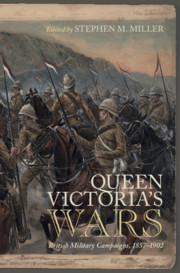Book contents
- Queen Victoria’s Wars
- Queen Victoria’s Wars
- Copyright page
- Contents
- Maps
- Contributors
- Acknowledgements
- 1 Introduction
- 2 The Indian Rebellion, 1857–1858
- 3 Punitive Expeditions in China, 1857–1860
- 4 The Expedition to Abyssinia, 1867–1868
- 5 The New Zealand Wars, 1845–1872
- 6 The Third Anglo-Asante War, 1873–1874
- 7 The Second Afghan War, 1878–1880
- 8 The Anglo-Zulu War, 1879
- 9 The First Anglo-Boer War, 1880–1881
- 10 Egypt and the Sudan, 1881–1885
- 11 The Third Anglo-Burmese War and the Pacification of Burma, 1885–1895
- 12 The Tirah Campaign, 1897–1898
- 13 Reconquest of the Sudan, 1896–1898
- 14 The South African War, 1899–1902
- 15 Conclusion
- Index
- References
3 - Punitive Expeditions in China, 1857–1860
Published online by Cambridge University Press: 01 June 2021
- Queen Victoria’s Wars
- Queen Victoria’s Wars
- Copyright page
- Contents
- Maps
- Contributors
- Acknowledgements
- 1 Introduction
- 2 The Indian Rebellion, 1857–1858
- 3 Punitive Expeditions in China, 1857–1860
- 4 The Expedition to Abyssinia, 1867–1868
- 5 The New Zealand Wars, 1845–1872
- 6 The Third Anglo-Asante War, 1873–1874
- 7 The Second Afghan War, 1878–1880
- 8 The Anglo-Zulu War, 1879
- 9 The First Anglo-Boer War, 1880–1881
- 10 Egypt and the Sudan, 1881–1885
- 11 The Third Anglo-Burmese War and the Pacification of Burma, 1885–1895
- 12 The Tirah Campaign, 1897–1898
- 13 Reconquest of the Sudan, 1896–1898
- 14 The South African War, 1899–1902
- 15 Conclusion
- Index
- References
Summary
The Second Opium War consisted of two interventions in 1858 and 1860. The first campaign resulted from disputed Anglo- French trading rights in China. Although opium importing into China triggered the controversy, commercial access more generally was at stake. A joint military expedition fought its way up the Peiho River to Tientsin where in a treaty (1858) the Chinese met British and French demands. Implementation proved difficult, however, especially when the Chinese imprisoned foreign diplomats and others. A second expedition, consisting of about 17,000 French, British and Indian army soldiers backed up by the Royal Navy, followed two years later and pushed to and up the Peiho River and on to Beijing. The expeditionary force reached Beijing quickly and secured the allies’ demands. They avoided unduly weakening the imperial government, since only stable government could uphold their trading rights. The campaigns will be examined in new ways, concentrating on the co-ordination of three distinctive armies, logistics, and the Indian army’s role. The war’s most controversial episode - the burning of the imperial summer palace at the campaign’s end - will be re-examined in relation to: the conduct of the war, its contemporary and later impact, and the emblematic use of such destructive acts in ‘colonial’ campaigning.
- Type
- Chapter
- Information
- Queen Victoria's WarsBritish Military Campaigns, 1857–1902, pp. 40 - 61Publisher: Cambridge University PressPrint publication year: 2021

